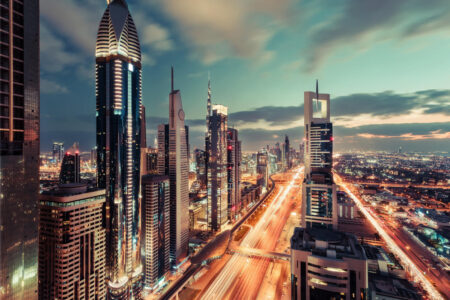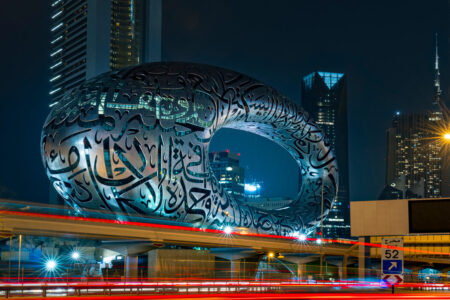Take a scenic drive along Sheikh Zayed Road
- February 9, 2024
- Discover Dubai
Do you want to experience a beautiful drive around Dubai? Then, Sheikh Zayed Road has got you covered. Located in the heart... Read More

Dubai, a city synonymous with architectural marvels and innovations, boasts two iconic landmarks that have captured the imagination of millions worldwide – the Burj Al Arab and the Burj Khalifa. These awe-inspiring structures not only exemplify human ingenuity but also serve as powerful symbols of prosperity for a nation that has risen from modest beginnings to become an indisputable player on the global stage.
The Burj Al Arab, often referred to as the world’s most luxurious hotel, stands majestically on its own artificial island off the coast of Dubai. On the other hand, the colossal Burj Khalifa reigns supreme as the tallest building in existence, piercing through the sky at an astonishing 828 meters.
A comparative exploration of these remarkable edifices reveals fascinating insights into their design principles, engineering feats, and cultural implications while simultaneously inspiring readers who possess an innate desire to contribute positively towards society. By examining this contrast between opulence and ambition embodied by these modern wonders – one may glean valuable lessons in striving for excellence and selflessly serving others.
Architectural grandeur, innovative design, and structural marvels define both the Burj Al Arab and the Burj Khalifa. These iconic buildings, located in Dubai, United Arab Emirates, have captured worldwide attention for their distinct styles and engineering feats. However, a closer examination of their architectural elements reveals significant differences between them.
The Burj Al Arab is known for its distinctive sail-shaped structure that requires unique materials to maintain its shape while withstanding harsh environmental conditions. The building’s exterior comprises two layers: an outer Teflon-coated fiberglass screen and an interior layer made from woven glass fiber fabric. This combination grants the structure flexibility and durability against wind loads as well as solar radiation protection.
In contrast, the Burj Khalifa stands tall with its tapering spire inspired by regional desert flowers and Islamic architecture patterns. Its Y-shaped floor plan maximizes views of the Arabian Gulf while ensuring stability by reducing wind forces on the tower through architectural setbacks at each tier.
While both towers boast impressive exteriors, it is within their walls where interior extravagance truly sets them apart. Stepping into the Burj Al Arab unveils a luxurious world filled with custom-designed furnishings, gold leaf accents covering 24-carat gold pillars and chandeliers crafted from Swarovski crystals.
On the other hand, visitors entering the majestic lobby of the Burj Khalifa are greeted by sleek modern designs featuring stainless steel columns adorned with intricate glass panels reflecting traditional Arabic motifs. Ultimately, these contrasting aesthetic choices serve to differentiate not only their visual appearances but also embody their respective purposes – one being an opulent hotel representing indulgence and leisure; whereas the other embodies progress as a symbol of innovation in urban living spaces catering to various aspects such as offices, residences, hotels or even observation decks offering breathtaking panoramic views over Dubai’s skyline.
Moving beyond the architectural design and aesthetics, it is crucial to delve into the engineering techniques and innovations that set these two iconic buildings apart.
The Burj Al Arab and the Burj Khalifa not only differ in their visual appeal but also in their approach to sustainable construction and use of innovative materials.
Sustainable construction plays a significant role in both structures; however, they employ different strategies to achieve this goal.
For instance, the Burj Al Arab relies on its sail-shaped design, which allows for natural light penetration and air circulation throughout the building, thereby reducing energy consumption.
In contrast, the Burj Khalifa incorporates several green technologies such as condensate recovery systems for irrigation purposes, high-performance glazing to reduce heat gain while maximizing daylight capture, and an intelligent building management system that monitors energy usage across various zones within the skyscraper.
Innovative materials have also been employed in constructing these marvels of modern architecture.
While both edifices boast impressive steel frameworks designed to withstand extreme weather conditions and seismic activity, each has unique attributes contributing to their structural stability.
Notably, Burj Al Arab’s exoskeleton employs diagrid technology—a network of diagonally intersecting trusses—while incorporating Teflon-coated fiberglass fabric acting as a shield against harsh climatic elements.
On the other hand, Burj Khalifa utilizes state-of-the-art reinforced concrete with high-strength rebar capable of resisting immense compressive forces generated by wind loads at elevated heights.
By embracing cutting-edge engineering solutions and prioritizing sustainability efforts, these remarkable towers continue inspiring future generations in service-oriented industries towards eco-friendly practices.
Functionality and Purpose
The Burj Al Arab and the Burj Khalifa, while both iconic landmarks in Dubai, serve distinct purposes with differing functional designs. The former stands as a symbol of luxury hospitality, boasting an ultra-luxurious hotel that has become synonymous with opulence and extravagance. Meanwhile, the latter represents a marvel of modern engineering and architecture, acting not only as a mixed-use building but also as a testament to human innovation.
As urban landscapes continue to evolve at an unprecedented pace globally, these two towering structures remain quintessential examples of how purposeful architecture can foster economic growth while simultaneously serving as beacons of national pride.
Their unique functionalities cater to diverse needs ranging from luxurious leisure experiences or comfortable living conditions to providing efficient workspaces or awe-inspiring vistas for tourists – all contributing factors towards solidifying Dubai’s position on the world stage as a hub for cutting-edge developments in numerous fields.
Thus through this juxtaposition between ostentatious hospitality offerings and ambitious infrastructural feats lies an underlying narrative about humanity’s innate desire for progress; one which transcends beyond individual aspirations towards fostering collective prosperity across borders – ultimately revealing how even our most grandiose creations are driven by an inherent need to contribute positively towards society at large, regardless of the challenges and obstacles that may arise along the way.
The Burj Al Arab and the Burj Khalifa are two of the most iconic landmarks in the world, renowned for their incredible architecture and size.
The Burj Al Arab is located in Dubai and is a luxurious hotel that is often referred to as the ‘world’s only seven-star hotel’.
The Burj Khalifa, also located in Dubai, is the tallest building in the world, standing at an incredible 830 meters tall.
Both of these structures are iconic symbols of human achievement and have had major impacts upon the culture and economy of the city they inhabit.
Arabian influences are deeply embedded in the design and cultural significance of both the Burj Al Arab and the Burj Khalifa, two iconic structures that have become symbols of Dubai’s rapid growth and development.
The Burj Al Arab, designed to resemble a billowing sail, draws inspiration from traditional Arabian sailing vessels known as dhows. This luxurious hotel has come to represent not only opulence but also a nod to the region’s seafaring heritage.
On the other hand, the Burj Khalifa stands tall as an architectural marvel blending Islamic architecture with modern design elements, making it a symbol of progress while still paying homage to its roots.
A luxury experience is synonymous with these two landmarks; however, their impact on culture varies significantly.
As a professional journalist might report, the Burj Al Arab primarily focuses on providing unparalleled hospitality services for those who can afford its extravagant accommodations. It boasts features such as personal butlers for each suite and a helipad-turned-tennis court atop its roof – all meant to cater to guests seeking exclusivity and indulgence.
Conversely, while the Burj Khalifa does house lavish residences and high-end offices within its towering structure, it also serves as a hub for tourists and locals alike due to its popular observation deck and surrounding attractions like malls and parks.
Engaging with these magnificent buildings fosters an understanding of how they contribute meaningfully toward enriching society through shared values rooted in helping others.
By showcasing Arabian cultural elements through their designs and offerings, both structures inspire pride among local Emiratis who appreciate seeing their traditions woven into contemporary icons representing prosperity for future generations.
In addition to this connection between past and present cultures, visitors get drawn towards experiencing firsthand what makes these creations stand out – whether it be enjoying fine dining at one of the world-class restaurants inside or taking in panoramic views from hundreds of meters above ground level.
Ultimately, by embodying elegance combined with purpose, the Burj Al Arab and the Burj Khalifa have managed to create an indelible mark on Dubai’s landscape and beyond.
The economic implications of these architectural marvels cannot be understated, as they have contributed significantly to Dubai’s meteoric rise on the global stage.
The Burj Al Arab and the Burj Khalifa serve not only as iconic symbols of cultural significance but also as catalysts for a tourism boost in the region. This influx of visitors seeking to experience these awe-inspiring structures has led to increased revenue from various sectors such as hospitality, retail, and entertainment.
As testament to their impact, both landmarks have played an instrumental role in shaping the city’s identity while simultaneously transforming its economy into one that is more diversified and resilient. Through attracting international attention and investments, they have helped solidify Dubai’s position as a leading destination for business and leisure travelers alike.
Furthermore, this growth has generated countless employment opportunities for locals, creating a ripple effect where prosperity is shared across communities – aligning with the values of service towards others.
In essence, it becomes evident that the cultural significance and impact of the Burj Al Arab and the Burj Khalifa extend far beyond their striking designs or luxury offerings. They are integral components in driving economic progress and fostering social development within Dubai – showcasing how architecture can transcend aesthetics by embodying purposeful change.
The comparison between the Burj Al Arab and the Burj Khalifa highlights important aspects that can be applied to future projects and developments. One of these is sustainable construction, a concept that emphasizes integrating environmentally friendly practices throughout a building’s life cycle–from design to demolition. Both structures incorporate innovative designs in their respective approaches; however, there are still lessons to be learned from each when considering sustainability.
Economic implications play an essential role in determining the success of any development project. The Burj Al Arab reflects luxury and exclusivity as it caters to affluent tourists seeking unique experiences. In contrast, the Burj Khalifa serves multiple purposes, including residential, commercial, and entertainment spaces while also functioning as a symbol of national pride.
Therefore, developers must consider socio-economic factors alongside environmental concerns when embarking on new ventures to ensure long-term viability and positive impacts on local communities.
Reflecting upon these iconic buildings allows stakeholders to assess how they have influenced others worldwide in terms of architecture, engineering feats, and urban planning strategies. By examining what worked well with sustainable construction methods and understanding economic implications associated with such landmark projects like those in Dubai, developers can create comprehensive plans tailored towards meeting society’s needs today without compromising future generations’ ability to meet theirs.
This approach promotes not only individual advancement but collective growth through service-oriented principles benefiting both immediate surroundings and global community alike.
In conclusion, the Burj Al Arab and Burj Khalifa are awe-inspiring architectural masterpieces that exemplify human ingenuity in creating structures of unparalleled beauty and functionality.
While both buildings stand tall as symbols of Dubai’s rapid growth and modernity, they differ significantly in their design, engineering techniques, purpose, and cultural impact.
One could liken these two iconic structures to shining beacons illuminating the path for future architects and engineers to follow.
The lessons learned from their construction can undoubtedly inspire innovative ideas for sustainable urban developments, ensuring that our cities continue to evolve with grace, sophistication, and resilience for generations to come.

Do you want to experience a beautiful drive around Dubai? Then, Sheikh Zayed Road has got you covered. Located in the heart... Read More

A Guide to Visiting The Dubai Museum If you are planning a trip to Dubai, you’ll undoubtedly want to take in some... Read More

Are you up for a game at the Emirates Golf Club? Come crossways one of the most well-known golf courses in the... Read More
Please enter your username or email address. You will receive a link to create a new password via email.